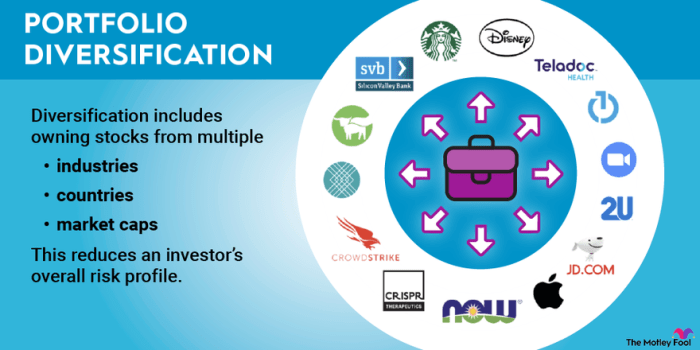
Embark on a journey into the realm of Diversification Investment Advice, where strategic decisions can lead to fruitful outcomes. Dive into the intricacies of diversifying your investment portfolio and unlocking its full potential.
Discover the key principles and techniques that can guide you towards making informed and effective investment choices.
Importance of Diversification in Investments
Diversification is a crucial strategy in investment portfolios as it helps spread risk across different asset classes, industries, and geographic regions. By not putting all your eggs in one basket, diversification can help protect your investments from the volatility of any single asset or market sector.
Mitigating Risk through Diversification
- Diversifying across asset classes: By investing in a mix of stocks, bonds, real estate, and commodities, you can reduce the impact of a downturn in any one sector on your overall portfolio.
- Geographic diversification: Investing in international markets can help mitigate the risk of economic downturns in a specific country or region.
- Industry diversification: Spread your investments across different industries to avoid being overly exposed to the risks associated with a particular sector.
Impact on Long-Term Investment Returns
- While diversification may limit the potential for outsized gains from a single investment, it also helps protect against significant losses that can occur from concentrated positions.
- Over the long term, a well-diversified portfolio can provide more consistent returns and reduce the impact of market fluctuations on your overall wealth.
- Studies have shown that diversification can lead to improved risk-adjusted returns, allowing investors to achieve their financial goals with less volatility.
Types of Investment Diversification

Diversification is a key strategy for managing investment risk and maximizing returns. There are various types of diversification strategies that investors can employ to achieve their financial goals.
Asset Allocation Diversification
Asset allocation diversification involves spreading investments across different asset classes, such as stocks, bonds, real estate, and commodities. This strategy helps reduce risk by not putting all eggs in one basket. For example, if one asset class underperforms, the impact on the overall portfolio is minimized due to the exposure to other asset classes.
Sector Diversification
Sector diversification involves investing in different sectors of the economy, such as technology, healthcare, consumer goods, and energy. By diversifying across sectors, investors can mitigate risks associated with sector-specific events or economic downturns. For instance, if one sector experiences a decline, investments in other sectors may help offset losses.
Geographical Diversification
Geographical diversification refers to investing in various regions or countries around the world. This strategy helps reduce exposure to country-specific risks, such as political instability, economic downturns, or currency fluctuations. By spreading investments globally, investors can benefit from different market trends and opportunities in a more balanced manner.Overall, incorporating a combination of asset allocation, sector, and geographical diversification strategies can help investors build a well-rounded investment portfolio that is more resilient to market fluctuations and uncertainties.
Risk Management through Diversification

Diversification is a key strategy in risk management when it comes to investments. By spreading your investments across different asset classes, industries, and geographical regions, you can reduce the overall risk in your portfolio.
Reducing Investment Risk
Diversification helps in reducing investment risk by ensuring that a single negative event does not have a catastrophic impact on your entire portfolio. For example, if you have all your investments in one sector and that sector experiences a downturn, your entire portfolio could suffer significant losses. However, by diversifying across different sectors, the impact of the downturn is minimized.
- Diversification spreads risk
- Reduces correlation between assets
- Protects against concentration risk
Protection Against Market Volatility
Market volatility can lead to sudden and significant fluctuations in the value of investments. Diversification can help protect against market volatility by offsetting losses in one asset class with gains in another. For instance, during a market downturn, assets like bonds or gold may perform well while stocks are declining, providing a buffer against losses.
Diversification acts as a safety net during turbulent market conditions.
Hedging Against Specific Risks
Diversification can also hedge against specific risks associated with certain industries or regions. For example, geopolitical events may impact stocks in a particular country, but by diversifying globally, you can mitigate the impact of such events on your overall portfolio. Similarly, investing in both growth and value stocks can help balance out risks associated with different investment styles.
- Geographical diversification
- Industry-specific risks
- Investment style diversification
Factors to Consider for Effective Diversification
When diversifying an investment portfolio, there are several key factors to consider to ensure effectiveness. These factors play a crucial role in managing risk and maximizing returns. Let’s explore some of the most important considerations.
Risk Tolerance and Diversification Choices
- Understanding your risk tolerance is essential when making diversification choices. Your risk tolerance refers to the amount of risk you are willing to take on in exchange for potential returns.
- Investors with a higher risk tolerance may opt for a more aggressive diversification strategy, including investments with higher volatility but potentially higher returns.
- Conversely, investors with a lower risk tolerance may prefer a more conservative approach, focusing on stable, low-risk investments to protect their capital.
Investment Horizon and Diversification Strategies
- The investment horizon, or the length of time you plan to hold your investments, plays a significant role in determining diversification strategies.
- For long-term investors with a lengthy investment horizon, diversification can help spread risk over time and potentially capture higher returns from a variety of asset classes.
- Short-term investors may focus more on short-term market trends and adjust their diversification strategies accordingly to capitalize on immediate opportunities or mitigate short-term risks.
Investment Opportunities for Diversification
Diversifying your investment portfolio involves exploring various investment options to spread risk and maximize returns.
Traditional vs. Alternative Investments
Traditional investments include stocks, bonds, and cash equivalents, while alternative investments encompass real estate, commodities, hedge funds, and private equity. By diversifying between these two categories, investors can reduce overall portfolio volatility and potentially achieve higher returns.
Enhancing Portfolio Performance
Diversification can enhance overall portfolio performance by reducing the impact of market fluctuations on a single asset class. When one investment underperforms, others may offset the losses, leading to a more stable and consistent return on investment.
Investment Strategy and Diversification
Diversification is a key component of a well-rounded investment strategy. By spreading your investments across different asset classes, industries, and geographical regions, you can reduce the overall risk in your portfolio and increase the likelihood of achieving your financial goals.
Aligning Diversification with Investment Goals
When developing an investment strategy, it is crucial to align diversification with your specific investment goals. For example, if your goal is long-term growth, you may opt for a more aggressive diversification approach that includes a mix of high-growth stocks and emerging markets. On the other hand, if your goal is capital preservation, a more conservative approach with a higher allocation to bonds and stable stocks may be more appropriate.
- Ensuring that your diversification strategy is in line with your investment goals helps to optimize your portfolio for the desired outcomes.
- Regularly reviewing and adjusting your diversification strategy as your goals evolve is essential to staying on track.
Examples of Successful Investment Strategies with Diversification
Successful investment strategies that incorporate diversification include:
- Modern Portfolio Theory (MPT): Developed by Harry Markowitz, MPT emphasizes the importance of diversification across assets with low correlations to reduce risk.
- Core-Satellite Approach: This strategy combines a diversified core portfolio with satellite positions in specific sectors or regions to enhance returns.
- Risk Parity: A strategy that allocates assets based on risk levels rather than traditional market capitalization, aiming to achieve a balanced risk-return profile.
In conclusion, Diversification Investment Advice offers a pathway to financial success by spreading risk and maximizing returns. By embracing diversification strategies, investors can navigate the unpredictable waters of the market with confidence and resilience.
Detailed FAQs
How does diversification impact investment risk?
Diversification helps to spread risk across different assets, reducing the impact of any single investment’s poor performance on the overall portfolio.
What factors should I consider when diversifying my portfolio?
Key factors to consider include your risk tolerance, investment goals, time horizon, and the correlation between different assets in your portfolio.
Can diversification protect against market volatility?
Yes, diversification can help cushion the impact of market fluctuations by having investments in various asset classes that respond differently to market conditions.





